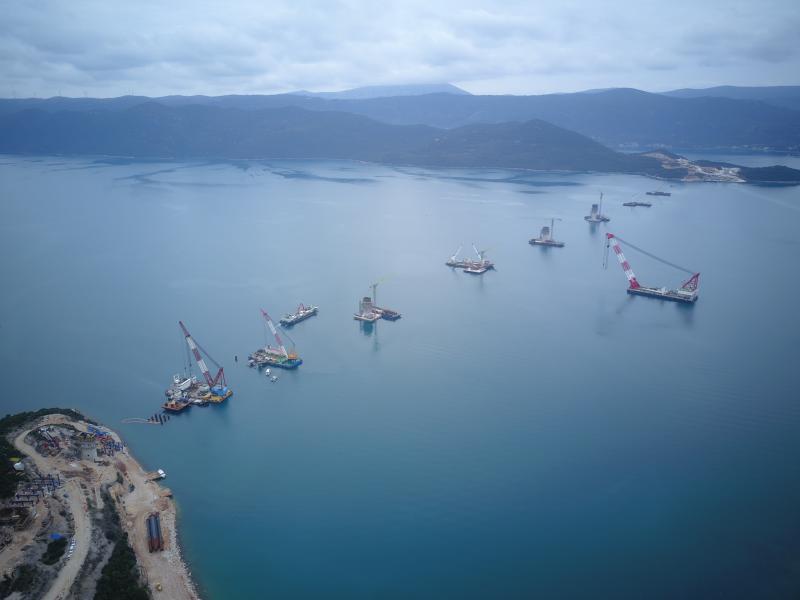-Thanks to the collaboration and hard work of Chinese and European staff, as well as efforts made by the European community to contain the virus, the BRI projects have moved forward at a steady pace.
-The BRI projects have become a lively practice which is eco-friendly, high-quality and sustainable.
BRUSSELS, Dec. 3 (Xinhua) -- With wind turbines spinning, highways stretching forward and seaports operating around the clock, the Belt and Road Initiative (BRI) projects from the Mediterranean to the Baltic have displayed vigor and resilience, bringing tangible benefits to Europe amid the COVID-19 pandemic.
Despite difficulties and challenges since the outbreak of the pandemic, constructors and operators of the China-assisted projects have been trying to get them back on track, embarking on a path of green, high-quality and benefit-sharing development.
RESPONSE TO PANDEMIC
During the first wave of COVID-19 infections in spring and summer, the on-site construction of the BRI projects in Europe has been suspended.
"The COVID-19 pandemic has inevitably delayed our project, as the production of steel box girders was halted, while international travel restrictions left us understaffed," said Lu Shengwei, a representative of China Road and Bridge Corporation (CRBC) in Croatia.

Aerial photo taken on Feb. 1, 2020 shows the construction site of the Peljesac Bridge near Komarna, Croatia. (Xinhua/Gao Lei)
The CRBC is working on the construction of the Peljesac Bridge, a 2.4-km-long bridge connecting the Croatian mainland with the Peljesac Peninsula. It is an iconic infrastructure project funded by the European Union (EU).
To catch up with the schedule, the company even ordered a direct charter flight for its welders, Lu told Xinhua.
In face of the challenges, the Fabryka Lozysk Tocznych-Krasnik S.A. (FLT-Krasnik), a bearings manufacturer in southeast Poland that was acquired by the Chinese Tri-Ring Group, managed to maintain all of its 1,650 employees.
Manos Tsakiltzis, a 54-year-old bus driver in Greece, recalled how he had lost his job when the virus struck the tourism industry earlier this year. Later he was hired as a short-term truck driver at the Piraeus Port, Europe's fourth-largest port run by China's COSCO Shipping.
Tsakiltzis said the protective measures implemented by the port were excellent and it is "a great pleasure" to work with his Chinese colleagues.
"I really appreciate it," Tsakiltzis said, referring to this job opportunity, adding that it has helped him and his family stand on their feet.
STEADY PACE FORWARD
Thanks to the collaboration and hard work of Chinese and European staff, as well as efforts made by the European community to contain the virus, the BRI projects have moved forward at a steady pace.

A wind turbine blade is installed at the construction site of the Senj Wind Farm in Senj, Croatia, Sept. 27, 2020. (Photo by Ding Decai/Xinhua)
Although the equipment of China's Norinco for the construction of the Senj Wind Farm had been stranded in Croatia's Zadar Port for three months, 50 percent of the contract value has been completed, Liu Zhen, general manager of Norinco's Zagreb branch, told Xinhua.
By the end of this year, 13 wind turbines on the farm will be ready for power generation and 39 wind turbines will be up and running by next April.
At Montenegro's Mt. Mozura, the wind turbines built by Shanghai Electric Power Company (SEP) have started spinning as the country's new highway stretches towards the border with Serbia.
TANGIBLE OPPORTUNITIES
As global growth has been weighed down by the pandemic, those who see the BRI projects in an objective and rational way may find better opportunities.
The BRI projects have become a lively practice which is eco-friendly, high-quality and sustainable.
One such project is the Peljesac Bridge in Croatia.
Niksa Orlandic, environmental engineer of the project, said the CRBC engineers have managed to make only slight impact on water streams when knocking steel piles into seabed.
They used a so-called "air bubble" noise-cancelling technology originating from submarines to protect dolphins in surrounding waters, noted the engineer.

Staff members work in the Fabryka Lozysk Tocznych-Krasnik S.A.(FLT-KRASNIK) on the outskirts of Krasnik, a small town in southeast Poland, June 18, 2019. (Xinhua/Chen Xu)
Aleksandar Milic, technical director of the Stanari Thermal Power Plant, the first China-built coal-fired power plant in Europe, said the operation of the plant in northern Bosnia and Herzegovina meets or even exceeds the EU standards for controlling emissions of sulfur dioxide, nitrogen oxide and dust.
Besides, the plant has attracted visits of companies from more than 30 countries, according to Hu Yang, China Dongfang Electric Corporation's operation and maintenance manager for the project.
"We are showcasing ... Chinese companies' capabilities in project design, construction, operation and maintenance," Hu said.
For the China-built solar power plant in Hungary's Kaposvar, with a total investment of around 100 million euros (about 121 million U.S. dollars), Hungary had no loan or electricity purchase fulfillment guarantee, which means that no government debt was added due to the project, said Meng Fanye, director of the project.
Rejecting the so-called "debt trap diplomacy" myth, Meng said that the China National Machinery Import and Export Corporation (CMC) invested equity capital, while Bank of China provided financing for the project. In the future, the CMC's investment will be amortized with electricity sales.
Besides, the power plant will contribute 2 million euros (about 2.42 million dollars) in taxes to local and state governments, he added. (Video reporters: Zhao Yuchao, Han Chong, Pan Geping, Yuan Liang, Shi Zhongyu and Gao Lei; Video editor: Zhou Saang.)



